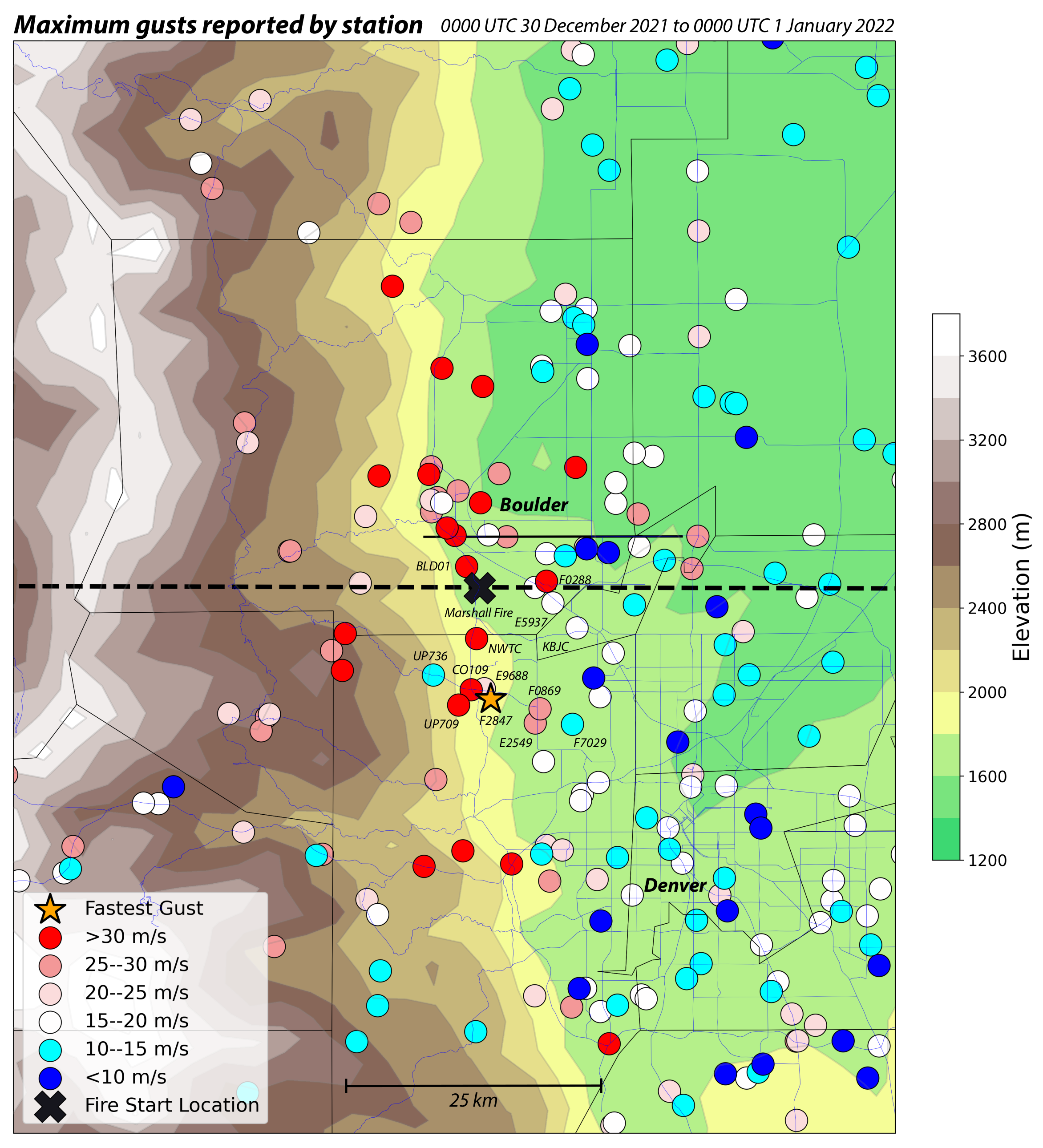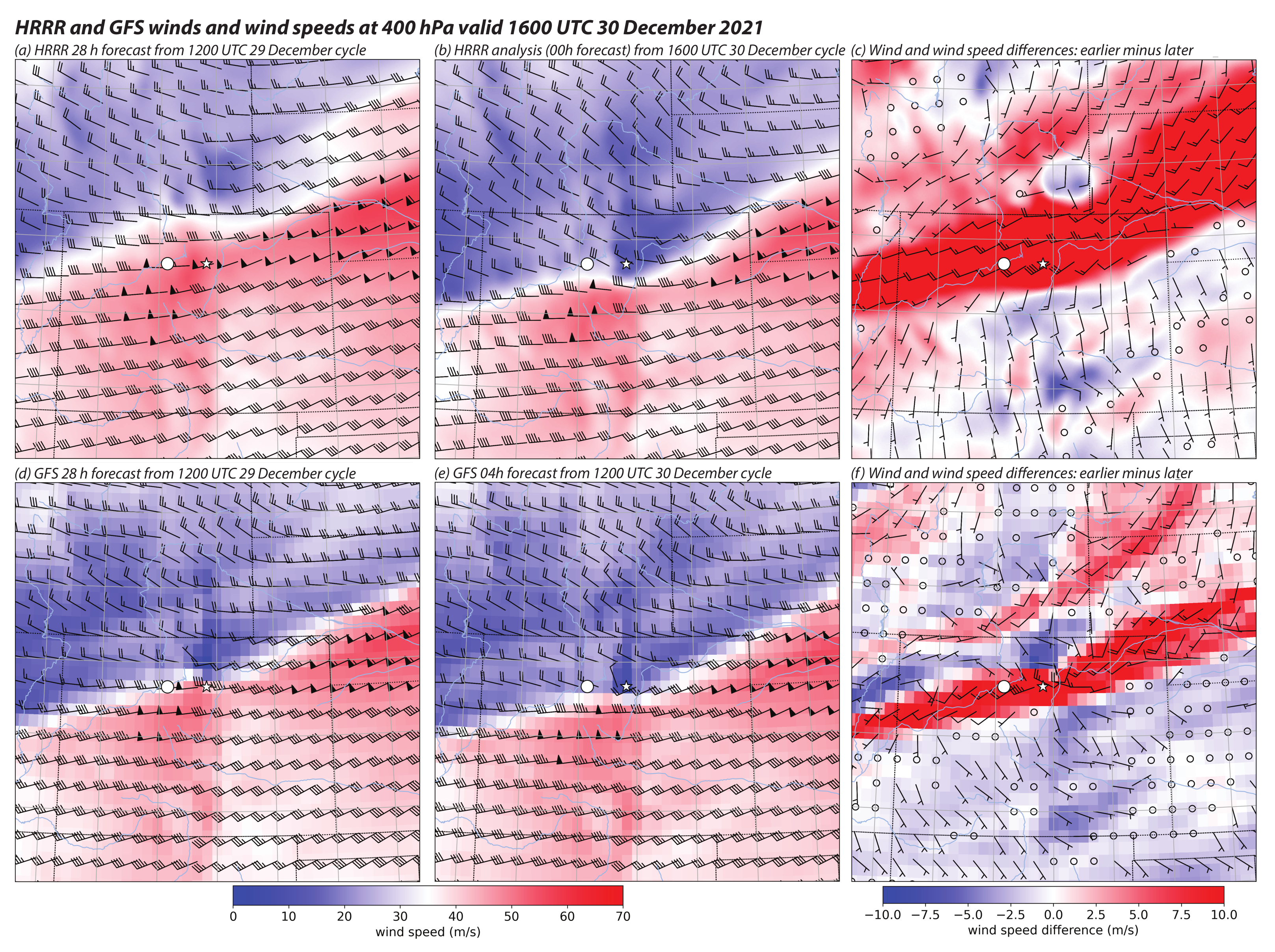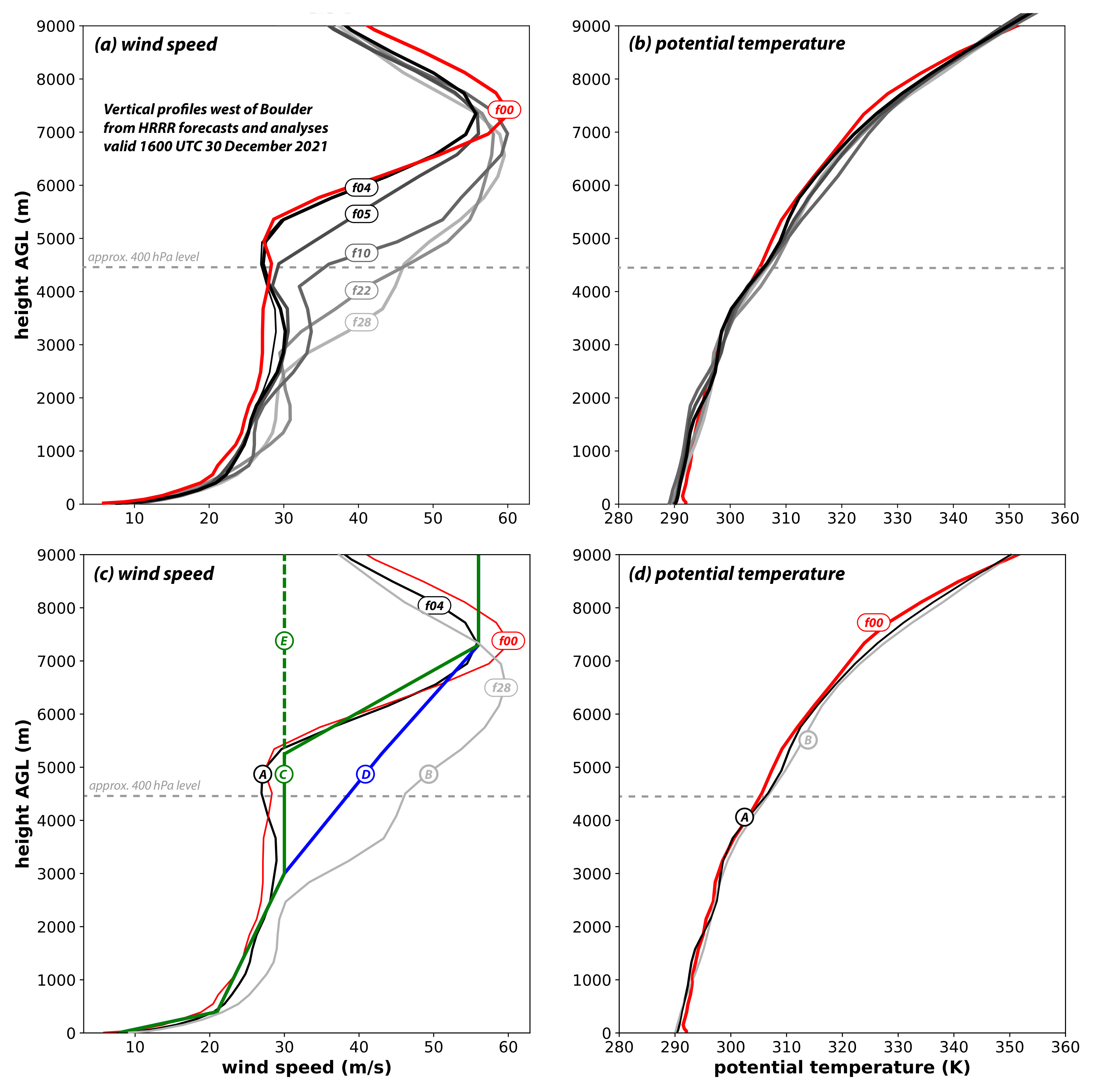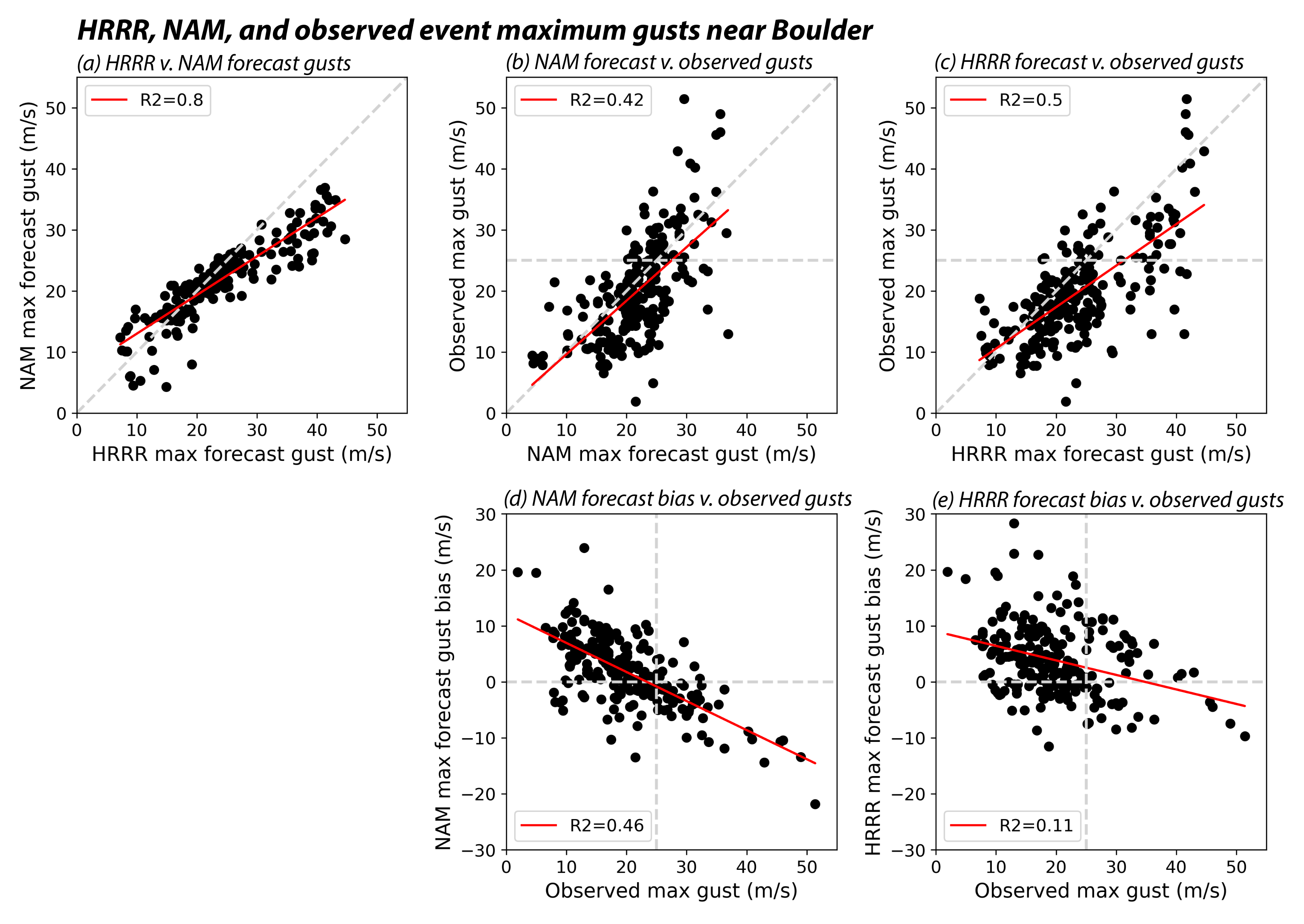The December 2021 Marshall Fire: Predictability and Gust Forecasts from Operational Models
Abstract
:1. Introduction
2. Materials and Methods
3. Surface Gust Observations and Synoptic Situation
3.1. Observations
3.2. Synoptic Situation
3.3. Conditions at and Upstream of Boulder
4. Operational Forecasts
5. The Role of the Inflow Environment
6. Operational Gust Forecasts
7. Discussion and Conclusions
Author Contributions
Funding
Institutional Review Board Statement
Informed Consent Statement
Data Availability Statement
Acknowledgments
Conflicts of Interest
Abbreviations
| AGL | Above Ground Level |
| APRSWXNET | Automatic Position Reporting System as a WX NETwork |
| ARW | Advanced Research WRF |
| ASOS | Automated Surface Observing System |
| AWOS | Automated Weather Observing System |
| CDOT | Colorado Department of Transportation |
| CONUS | Conterminous United States |
| DOT | Department of Transportation |
| GFS | Global Forecast System |
| GPM | Geopotential Meters |
| HRRR | High-Resolution Rapid Refresh |
| MADIS | Meteorological Assimilation Data Ingest System |
| MET | Model Evaluation Tools |
| METAR | Meteorological Terminal Aviation Routine Weather Report |
| MSL | Mean Sea Level |
| NAM | North American Mesoscale |
| NOAA | National Oceanic and Atmospheric Administration |
| NWS | National Weather Service |
| NWTC | National Wind Technology Center |
| PBL | Planetary Boundary Layer |
| RAWS | Remote Automated Weather Stations |
| UPP | Unified Post Processor |
| WMO | World Meteorological Organization |
| WRF | Weather Research and Forecasting |
References
- Brown, J.; Paul, J. The Minute-by-Minute Story of the Marshall Fire’s Wind-Fueled Tear through Boulder County. Available online: https://coloradosun.com/2022/01/06/marshall-fire-boulder-county-timeline/ (accessed on 10 February 2022).
- National Weather Service Denver/Boulder CO. High Winds and Marshall Fire on December 30th. 2021. Available online: https://www.weather.gov/bou/HighWinds12_30_2021 (accessed on 1 March 2022).
- Case, A. Man Who Died in Marshall Fire Identified. Available online: https://www.9news.com/article/news/local/wildfire/marshall-fire/remains-found-marshall-fire/73-1350bf65-e965-40f3-a11f-4727d57b6fe5 (accessed on 3 March 2022).
- Paul, J.; Vo, T.; Prentzel, O.; Najmabadi, S. As many as 600 Homes Lost, 6 People Injured as Marshall Fire Quickly Spreads across Boulder County. Available online: https://coloradosun.com/2021/12/30/boulder-grass-fire-evacuations/ (accessed on 3 March 2022).
- Boulder County Office of Disaster Management. Marshall Fire Damage Assessment. Available online: https://assets.bouldercounty.org/wp-content/uploads/2022/01/marshall-fire-damage-assessment-list.pdf (accessed on 10 February 2022).
- Boulder County Fire Is Most Destructive in State History after Burning 991 Structures. Available online: https://www.9news.com/article/news/local/wildfire/boulder-county-fire-most-destructive-in-state-history/73-b1ffd46e-abff-46aa-acfe-37cbec423928 (accessed on 3 March 2022).
- Glossary of Meteorology: Downslope windstorm. Available online: https://glossary.ametsoc.org/wiki/Downslope_windstorm (accessed on 2 March 2022).
- Durran, D.R. Downslope winds. In Encyclopedia of Atmospheric Sciences; North, G.R., Pyle, J.A., Zhang, F., Eds.; Elsevier Science: Amsterdam, The Netherlands, 2003; pp. 644–650. [Google Scholar]
- Whiteman, C.D. Mountain Meteorology, Fundamentals and Applications; Oxford University Press: Oxford, UK; New York, NY, USA, 2000. [Google Scholar]
- Smith, R.B. 100 years of progress on mountain meteorology research. Meteorol. Monogr. 2019, 59, 20.1–20.73. [Google Scholar] [CrossRef]
- McClung, B.; Mass, C.F. The strong, dry winds of Central and Northern California: Climatology and synoptic evolution. Weather Forecast. 2020, 35, 2163–2178. [Google Scholar] [CrossRef]
- Rolinski, T.; Capps, S.B.; Zhuang, W. Santa Ana winds: A descriptive climatology. Weather Forecast. 2019, 34, 257–275. [Google Scholar] [CrossRef]
- Blier, W. The Sundowner winds of Santa Barbara, California. Weather Forecast. 1998, 13, 702–716. [Google Scholar] [CrossRef]
- Morris, P.S. Encyclopedia of the Great Plains: Chinook Stories. Available online: http://plainshumanities.unl.edu/encyclopedia/doc/egp.fol.006 (accessed on 15 February 2022).
- Brinkman, W.A.R. Strong downslope winds at Boulder, Colorado. Mon. Weather Rev. 1974, 102, 592–602. [Google Scholar] [CrossRef] [Green Version]
- Klemp, J.B.; Lilly, D.K. The dynamics of wave-induced downslope winds. J. Atmos. Sci. 1975, 32, 320–339. [Google Scholar] [CrossRef] [Green Version]
- Mercer, A.E.; Richman, M.B.; Bluestein, H.B.; Brown, J.M. Statistical modeling of downslope windstorms in Boulder, Colorado. Weather Forecast. 2008, 23, 1176–1194. [Google Scholar] [CrossRef] [Green Version]
- NOAA Physical Sciences Laboratory. Boulder Wind Info. Available online: https://psl.noaa.gov/boulder/wind.html (accessed on 10 February 2022).
- Brewer, M.B.; Clements, C.B. The 2018 Camp Fire: Meteorological analysis using in situ observations and numerical simulations. Atmosphere 2020, 11, 47. [Google Scholar] [CrossRef] [Green Version]
- Mass, C.F.; Ovens, D. The synoptic and mesoscale evolution accompanying the 2018 Camp Fire of Northern California. Bull. Am. Meteorol. Soc. 2021, 10, 168–192. [Google Scholar] [CrossRef]
- Fovell, R.G.; Cao, Y. The Santa Ana winds of Southern California: Winds, gusts, and the 2007 Witch fire. Wind Struct. 2017, 24, 529–564. [Google Scholar] [CrossRef]
- Nauslar, N.J.; Abatzoglou, J.T.; Marsh, P.T. The 2017 North Bay and Southern California fires: A case study. Fire 2018, 1, 18. [Google Scholar] [CrossRef] [Green Version]
- Fovell, R.G.; Gallagher, A. Winds and gusts during the Thomas fire. Fire 2018, 1, 3. [Google Scholar] [CrossRef] [Green Version]
- Duine, G.-J.; Jones, C.; Carvalho, L.M.V.; Fovell, R.G. Simulating Sundowner winds in coastal Santa Barbara: Model validation and sensitivity. Atmosphere 2019, 10, 155. [Google Scholar] [CrossRef] [Green Version]
- Mass, C.F.; Ovens, D.; Conrick, R.; Saltenberger, J. The September 2020 wildfires over the Pacific Northwest. Weather Forecast. 2022, 36, 1843–1865. [Google Scholar] [CrossRef]
- Coen, J.L.; Schroeder, W. The High Park fire: Coupled weather-wildland fire model simulation of a windstorm-driven wildfire in Colorado’s Front Range. J. Geophys. Res. Atmos. 2014, 120, 131–146. [Google Scholar] [CrossRef]
- Boulder County Wildfire History. Available online: https://www.bouldercounty.org/disasters/wildfires/maps-and-videos/ (accessed on 10 February 2022).
- Abatzoglou, J.T.; Smith, C.M.; Swain, D.L.; Ptak, T.; Kolden, C.A. Population exposure to pre-emptive de-energization aimed at averting wildfires in Northern California. Environ. Res. Lett. 2020, 15, 094046. [Google Scholar] [CrossRef]
- Zigner, K.; Carvalho, L.M.V.; Peterson, S.; Fujioka, F.; Duine, G.-J.; Jones, C.; Roberts, D.; Moritz, M. Evaluating the ability of FARSITE to simulate wildfires influenced by extreme, downslope winds in Santa Barbara, California. Fire 2020, 3, 29. [Google Scholar] [CrossRef]
- Monedero, S.; Ramirez, J.; Cardil, A. Predicting fire spread and behaviour on the fireline. Wildfire analyst pocket: A mobile app for wildland fire prediction. Ecol. Model. 2019, 392, 103–107. [Google Scholar] [CrossRef]
- Finney, M.A. FARSITE: Fire Area Simulator—Model Development and Evaluation; US Department of Agriculture, Forest Service, Rocky Mountain Research Station: Ogden, UT, USA, 1998; pp. 1–36. [Google Scholar] [CrossRef]
- Andrews, P.L. Current status and future needs of the BehavePlus Fire Modeling System. Int. J. Wildl. Fire 2014, 23, 21–33. [Google Scholar] [CrossRef] [Green Version]
- Durran, D.R. Another look at downslope windstorms. Part I: The development of analogs to supercritical flow in an infinitely deep, continuously stratified fluid. J. Atmos. Sci. 1986, 43, 2527. [Google Scholar] [CrossRef]
- Sheridan, P.F.; Vosper, S.B. A flow regime diagram for forecasting lee waves, rotors and downslope winds. Meteorol. Appl. 2006, 13, 179–195. [Google Scholar] [CrossRef] [Green Version]
- Smith, R.B. Interacting mountain waves and boundary layers. J. Atmos. Sci. 2007, 64, 594–607. [Google Scholar] [CrossRef]
- Reinecke, P.A.; Durran, D.R. Initial-condition sensitivities and the predictability of downslope winds. J. Atmos. Sci. 2009, 66, 3401–3418. [Google Scholar] [CrossRef]
- Reinecke, P.A.; Durran, D.R. The overamplification of gravity waves in numerical solutions to flow over topography. Mon. Weather Rev. 2009, 137, 1533–1549. [Google Scholar] [CrossRef] [Green Version]
- Hertenstein, R.F.; Kuettner, J.P. Rotor types associated with steep lee topography. Tellus 2005, 57, 117–135. [Google Scholar] [CrossRef]
- Cao, Y.; Fovell, R.G. Downslope windstorms of San Diego County. Part I: A case study. Mon. Weather Rev. 2016, 144, 529–552. [Google Scholar] [CrossRef]
- Cannon, F.; Carvalho, L.M.V.; Jones, C.; Hall, T.; Gomberg, D.; Dumas, J.; Jackson, M. WRF simulation of downslope wind events in coastal Santa Barbara County. Atmos. Res. 2017, 191, 57–73. [Google Scholar] [CrossRef] [Green Version]
- Cao, Y.; Fovell, R.G. Downslope windstorms of San Diego County. Part II: Physics ensemble analyses and gust forecasting. Weather Forecast. 2018, 33, 539–559. [Google Scholar] [CrossRef]
- Olson, J.B.; Kenyon, J.S.; Djalalova, I.; Bianco, L.; Turner, D.D.; Pichugina, Y.; Choukulkar, A.; Toy, M.D.; Brown, J.M.; Angevine, W.M.; et al. Improving Wind Energy Forecasting through Numerical Weather Prediction Model Development. Bull. Am. Meteorol. Soc. 2019, 100, 2201–2220. [Google Scholar] [CrossRef]
- Pichugina, Y.L.; Banta, R.M.; Bonin, T.; Brewer, W.A.; Choukulkar, A.; McCarty, B.J.; Baidar, S.; Draxl, C.; Fernando, H.J.S.; Kenyon, J.; et al. Spatial variability of winds and HRRR–NCEP model error statistics at three Doppler-lidar sites in the wind-energy generation region of the Columbia River Basin. J. Appl. Meteorol. Climatol. 2019, 58, 1633–1656. [Google Scholar] [CrossRef]
- Lee, T.R.; Buban, M.; Turner, D.D.; Meyers, T.P.; Baker, C.B. Evaluation of the High-Resolution Rapid Refresh (HRRR) model using near-surface meteorological and flux observations from northern Alabama. Weather Forecast. 2019, 34, 635–663. [Google Scholar] [CrossRef]
- Fovell, R.G.; Gallagher, A. Boundary layer and surface verification of the High-Resolution Rapid Refresh, version 3. Weather Forecast 2020, 35, 2255–2278. [Google Scholar] [CrossRef]
- Fovell, R.G.; Gallagher, A. An evaluation of surface wind and gust forecasts from the High-Resolution Rapid Refresh Model. Weather Forecast 2022, in press. [Google Scholar] [CrossRef]
- Clark, T.L.; Hall, W.D.; Kerr, R.M.; Middleton, D.; Radke, L.; Ralph, F.M.; Neiman, P.J.; Levinson, D. Origins of aircraft-damaging clear-air turbulence during the 9 December 1992 Colorado downslope windstorm: Numerical simulations and comparison with observations. J. Atmos. Sci. 2000, 57, 1105–1131. [Google Scholar] [CrossRef]
- Doyle, J.D.; Durran, D.R. The dynamics of mountain-wave-induced rotors. J. Atmos. Sci. 2002, 59, 186–201. [Google Scholar] [CrossRef]
- Doyle, J.D.; Jiang, Q.; Reinecke, P.A. Numerical modeling and predictability of mountain wave-induced turbulence and rotors. In Aviation Turbulence; Sharman, R., Lane, T., Eds.; Springer: Cham, Switzerland, 2016; pp. 357–384. [Google Scholar]
- Dowell, D.C.; Alexander, C.R.; James, E.P.; Weygandt, S.S.; Benjamin, S.G.; Manikin, G.S.; Blake, B.T.; Brown, J.M.; Olson, J.B.; Hu, M.; et al. The High-Resolution Rapid Refresh (HRRR): An hourly updating convection-allowing forecast model. Part 1: Motivation and system description. Weather Forecast 2022. in review. [Google Scholar]
- Benjamin, S.G.; James, E.P.; Brown, J.M.; Szoke, E.J.; Kenyon, J.S.; Ahmadov, R.; Turner, D.D. Diagnostic Fields Developed for Hourly Updated NOAA Weather Models; Earth System Research Laboratory, Global Systems Laboratory, National Oceanic and Atmospheric Administration NOAA: Boulder, CO, USA, 2021. Available online: https://repository.library.noaa.gov/view/noaa/32904 (accessed on 1 January 2022)Technical Report OAR GSL-66.
- Lilly, D.K. A severe downslope windstorm and aircraft turbulence event induced by a mountain wave. J. Atmos. Sci. 1978, 35, 59–77. [Google Scholar] [CrossRef] [Green Version]
- Smith, R.B. On severe downslope winds. J. Atmos. Sci. 1985, 42, 2597–2603. [Google Scholar] [CrossRef] [Green Version]
- Durran, D.R.; Klemp, J.B. Another look at downslope winds. Part II: Nonlinear amplification beneath wave-overturning layers. J. Atmos. Sci. 1987, 44, 3402–3412. [Google Scholar] [CrossRef] [Green Version]
- Bryan, G.H.; Fritsch, J.M. A benchmark simulation for moist nonhydrostatic numerical models. Mon. Weather Rev. 2002, 130, 2917–2928. [Google Scholar] [CrossRef]
- Durran, D.R.; Klemp, J.B. A compressible model for the simulation of moist mountain waves. Mon. Weather Rev. 1983, 111, 2341–2361. [Google Scholar] [CrossRef]
- Warner, T.T.; Peterson, R.A.; Treadon, R.E. A tutorial on lateral boundary conditions as a basic and potentially serious limitation to regional numerical weather prediction. Bull. Am. Meteorol. Soc. 1997, 78, 2599–2617. [Google Scholar] [CrossRef] [Green Version]
- Warner, T.T.; Key, L.E.; Lario, A.M. Sensitivity of mesoscale model forecast skill to some initial data characteristics: Data density, data position analysis procedure, and measurement error. Mon. Weather Rev. 1989, 117, 1281–1310. [Google Scholar] [CrossRef] [Green Version]
- Errico, R.M.; Vukicevic, T.; Raeder, K. Comparison of initial and boundary condition sensitivity for a limited-area model. Tellus 1993, 45A, 539–557. [Google Scholar] [CrossRef]
- Torn, R.D.; Hakim, G.J.; Snyder, C. Boundary conditions for limited-area ensemble Kalman filters. Mon. Weather Rev. 2006, 134, 2490–2502. [Google Scholar] [CrossRef]
- James, E.P.; Benjamin, S.G. Observation system experiments with the hourly updating Rapid Refresh model Using GSI hybrid ensemble-variational data assimilation. Mon. Weather Rev. 2017, 145, 2897–2916. [Google Scholar] [CrossRef]
- The Global Forecast System. Available online: https://www.emc.ncep.noaa.gov/emc/pages/numerical_forecast_systems/gfs/documentation.php (accessed on 3 March 2022).
- The Unified Post Processor (UPP). Available online: https://dtcenter.org/community-code/unified-post-processor-upp (accessed on 1 March 2022).














Publisher’s Note: MDPI stays neutral with regard to jurisdictional claims in published maps and institutional affiliations. |
© 2022 by the authors. Licensee MDPI, Basel, Switzerland. This article is an open access article distributed under the terms and conditions of the Creative Commons Attribution (CC BY) license (https://creativecommons.org/licenses/by/4.0/).
Share and Cite
Fovell, R.G.; Brewer, M.J.; Garmong, R.J. The December 2021 Marshall Fire: Predictability and Gust Forecasts from Operational Models. Atmosphere 2022, 13, 765. https://doi.org/10.3390/atmos13050765
Fovell RG, Brewer MJ, Garmong RJ. The December 2021 Marshall Fire: Predictability and Gust Forecasts from Operational Models. Atmosphere. 2022; 13(5):765. https://doi.org/10.3390/atmos13050765
Chicago/Turabian StyleFovell, Robert G., Matthew J. Brewer, and Richard J. Garmong. 2022. "The December 2021 Marshall Fire: Predictability and Gust Forecasts from Operational Models" Atmosphere 13, no. 5: 765. https://doi.org/10.3390/atmos13050765
APA StyleFovell, R. G., Brewer, M. J., & Garmong, R. J. (2022). The December 2021 Marshall Fire: Predictability and Gust Forecasts from Operational Models. Atmosphere, 13(5), 765. https://doi.org/10.3390/atmos13050765






